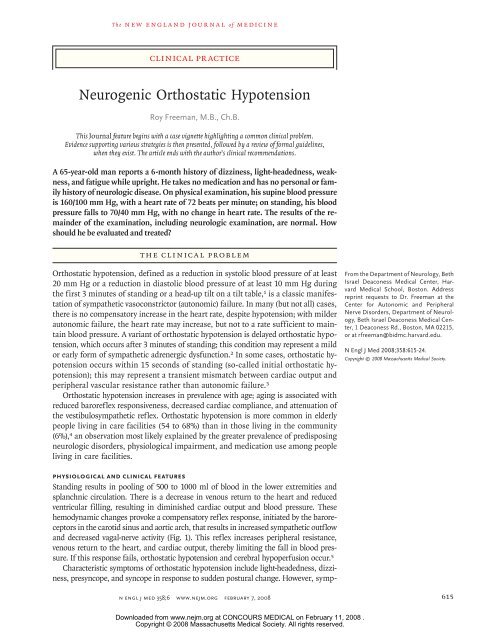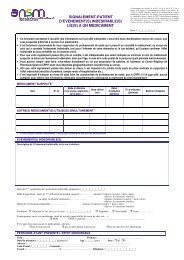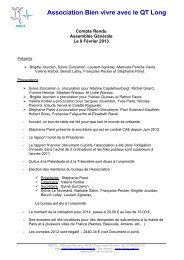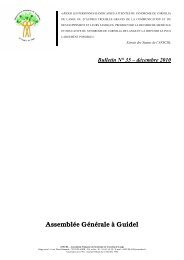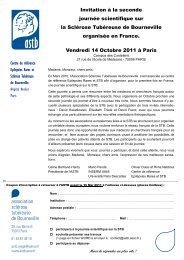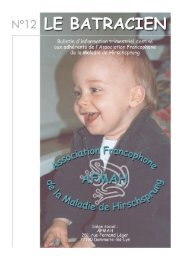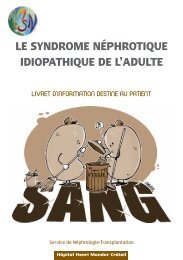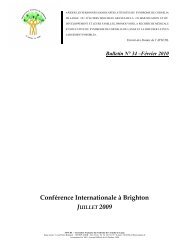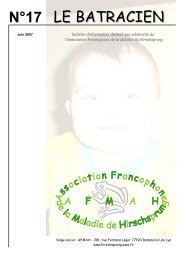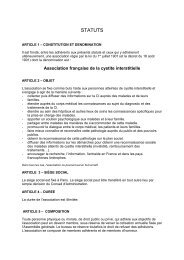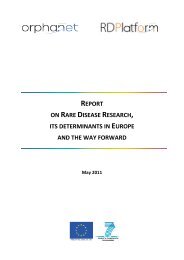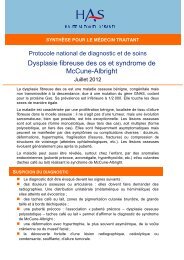Neurogenic Orthostatic Hypotension
Neurogenic Orthostatic Hypotension
Neurogenic Orthostatic Hypotension
Create successful ePaper yourself
Turn your PDF publications into a flip-book with our unique Google optimized e-Paper software.
T h e n e w e ng l a nd j o u r na l o f m e dic i n e<br />
clinical practice<br />
<strong>Neurogenic</strong> <strong>Orthostatic</strong> <strong>Hypotension</strong><br />
Roy Freeman, M.B., Ch.B.<br />
This Journal feature begins with a case vignette highlighting a common clinical problem.<br />
Evidence supporting various strategies is then presented, followed by a review of formal guidelines,<br />
when they exist. The article ends with the author’s clinical recommendations.<br />
A 65-year-old man reports a 6-month history of dizziness, light-headedness, weakness,<br />
and fatigue while upright. He takes no medication and has no personal or family<br />
history of neurologic disease. On physical examination, his supine blood pressure<br />
is 160/100 mm Hg, with a heart rate of 72 beats per minute; on standing, his blood<br />
pressure falls to 70/40 mm Hg, with no change in heart rate. The results of the remainder<br />
of the examination, including neurologic examination, are normal. How<br />
should he be evaluated and treated?<br />
The Cl inic a l Problem<br />
<strong>Orthostatic</strong> hypotension, defined as a reduction in systolic blood pressure of at least<br />
20 mm Hg or a reduction in diastolic blood pressure of at least 10 mm Hg during<br />
the first 3 minutes of standing or a head-up tilt on a tilt table, 1 is a classic manifestation<br />
of sympathetic vasoconstrictor (autonomic) failure. In many (but not all) cases,<br />
there is no compensatory increase in the heart rate, despite hypotension; with milder<br />
autonomic failure, the heart rate may increase, but not to a rate sufficient to maintain<br />
blood pressure. A variant of orthostatic hypotension is delayed orthostatic hypotension,<br />
which occurs after 3 minutes of standing; this condition may represent a mild<br />
or early form of sympathetic adrenergic dysfunction. 2 In some cases, orthostatic hypotension<br />
occurs within 15 seconds of standing (so-called initial orthostatic hypotension);<br />
this may represent a transient mismatch between cardiac output and<br />
peripheral vascular resistance rather than autonomic failure. 3<br />
<strong>Orthostatic</strong> hypotension increases in prevalence with age; aging is associated with<br />
reduced baroreflex responsiveness, decreased cardiac compliance, and attenuation of<br />
the vestibulosympathetic reflex. <strong>Orthostatic</strong> hypotension is more common in elderly<br />
people living in care facilities (54 to 68%) than in those living in the community<br />
(6%), 4 an observation most likely explained by the greater prevalence of predisposing<br />
neurologic disorders, physiological impairment, and medication use among people<br />
living in care facilities.<br />
Physiological and Clinical Features<br />
Standing results in pooling of 500 to 1000 ml of blood in the lower extremities and<br />
splanchnic circulation. There is a decrease in venous return to the heart and reduced<br />
ventricular filling, resulting in diminished cardiac output and blood pressure. These<br />
hemodynamic changes provoke a compensatory reflex response, initiated by the baroreceptors<br />
in the carotid sinus and aortic arch, that results in increased sympathetic outflow<br />
and decreased vagal-nerve activity (Fig. 1). This reflex increases peripheral resistance,<br />
venous return to the heart, and cardiac output, thereby limiting the fall in blood pressure.<br />
If this response fails, orthostatic hypotension and cerebral hypoperfusion occur. 5<br />
Characteristic symptoms of orthostatic hypotension include light-headedness, dizziness,<br />
presyncope, and syncope in response to sudden postural change. However, symp-<br />
From the Department of Neurology, Beth<br />
Israel Deaconess Medical Center, Harvard<br />
Medical School, Boston. Address<br />
reprint requests to Dr. Freeman at the<br />
Center for Autonomic and Peripheral<br />
Nerve Disorders, Department of Neurology,<br />
Beth Israel Deaconess Medical Center,<br />
1 Deaconess Rd., Boston, MA 02215,<br />
or at rfreeman@bidmc.harvard.edu.<br />
N Engl J Med 2008;358:615-24.<br />
Copyright © 2008 Massachusetts Medical Society.<br />
n engl j med 358;6 www.nejm.org february 7, 2008 615<br />
Downloaded from www.nejm.org at CONCOURS MEDICAL on February 11, 2008 .<br />
Copyright © 2008 Massachusetts Medical Society. All rights reserved.
616<br />
Aortic<br />
arch<br />
Baroreceptor<br />
Carotid<br />
sinus<br />
Afferent pathway<br />
Baroreceptor<br />
Figure 1. The Baroreflex.<br />
toms may be absent or nonspecific, such as generalized<br />
weakness, fatigue, nausea, cognitive slowing,<br />
leg buckling, or headache. Visual blurring may occur,<br />
probably because of retinal or occipital-lobe<br />
ischemia. Neck pain may occur, typically in the<br />
suboccipital, posterior cervical, and shoulder region<br />
(called the coat-hanger headache), which is<br />
most likely due to ischemia in the trapezius and<br />
neck muscles. 6 Patients may report orthostatic dyspnea<br />
(thought to reflect ventilation–perfusion mismatch<br />
due to inadequate perfusion of ventilated<br />
lung apexes) 7 or angina (attributed to impaired<br />
myocardial perfusion even in patients with normal<br />
T h e n e w e ng l a nd j o u r na l o f m e dic i n e<br />
PVN<br />
SON<br />
NTS<br />
A1<br />
CVLM<br />
RVLM<br />
NA<br />
Sympathetic<br />
ganglion<br />
Efferent pathway<br />
n engl j med 358;6 www.nejm.org february 7, 2008<br />
Sinus<br />
node<br />
Heart<br />
Blood<br />
vessel<br />
— that are situated in the carotid sinus and aortic arch. This COLOR leads to FIGURE a reduction in the afferent impulses that are relayed from these<br />
mechanoreceptors through the glossopharyngeal and vagus nerves to the nucleus of the tractus solitarius (NTS) in the dorsomedial me-<br />
Draft 4 01/22/07<br />
dulla. The reduced baroreceptor afferent activity produces a decrease in vagal nerve input to the sinus node that is mediated by the neu-<br />
Author Freeman<br />
roanatomical connections of the NTS to the nucleus ambiguus (NA). There is an increase in sympathetic efferent activity that is mediat-<br />
Fig # 1<br />
ed by the NTS projections to the caudal ventrolateral Title medulla (CVLM) (an excitatory pathway) and from there to the rostral ventrolateral<br />
medulla (RVLM) (an inhibitory pathway). The activation ME of RVLM presympathetic neurons in response to hypotension is thus predominantly<br />
due to disinhibition. In response to a sustained DE fall in blood pressure, vasopressin release is mediated by projections from the A1<br />
noradrenergic cell group in the ventrolateral medulla. Artist This projection SBL activates vasopressin-synthesizing neurons in the magnocellular<br />
portion of the paraventricular nucleus (PVN) and the supraoptic nucleus (SON) of the hypothalamus. Blue denotes sympathetic neurons<br />
and green parasympathetic neurons.<br />
AUTHOR PLEASE NOTE:<br />
Figure has been redrawn and type has been reset<br />
Please check carefully<br />
Issue date<br />
Vasopressin<br />
A decrease in arterial pressure unloads the baroreceptors — the terminals of afferent fibers of the glossopharyngeal and vagus nerves<br />
coronary arteries). One or more of these nonspecific<br />
symptoms may be the presenting or only symptom<br />
of orthostatic hypotension. Symptoms may<br />
be exacerbated by exertion, prolonged standing,<br />
increased ambient temperature, or eating. Syncope<br />
is usually preceded by warning symptoms but may<br />
occur suddenly, suggesting the possibility of a seizure<br />
or cardiac cause.<br />
Supine hypertension is common in patients<br />
with orthostatic hypotension, affecting more than<br />
50% of patients in some series. <strong>Orthostatic</strong> hypotension<br />
may occur after therapy for hypertension,<br />
and supine hypertension may follow treatment of<br />
Downloaded from www.nejm.org at CONCOURS MEDICAL on February 11, 2008 .<br />
Copyright © 2008 Massachusetts Medical Society. All rights reserved.
Table 1. Primary Autonomic Degenerative Disorders Causing <strong>Orthostatic</strong> <strong>Hypotension</strong> (the Synucleinopathies).*<br />
Other Prominent<br />
Clinical Features Pathological Hallmark Diagnostic Tests<br />
Disorder Autonomic Dysfunction Motor Manifestations<br />
MRI of brain may show abnormalities,<br />
including<br />
putaminal atrophy, putaminal<br />
hypointensity<br />
relative to pallidum on<br />
T2-weighted images, slitlike<br />
signal change at<br />
posterolateral putaminal<br />
margin, atrophy and signal<br />
change in pons, middle<br />
cerebellar peduncle,<br />
and cerebellum13 α-Synuclein precipitation in<br />
glia (glial cytoplasmic inclusions)<br />
and some CNS<br />
neurons<br />
Dysarthria, stridor, contractures<br />
and dystonias (particularly<br />
antecollis), REM<br />
sleep behavior disorder,<br />
dementia<br />
Parkinsonism† (predominant<br />
in 80% of patients), cerebellar<br />
dysfunction (predominant<br />
in 20% of patients),<br />
corticospinal tract<br />
abnormalities<br />
Severe autonomic dysfunction<br />
develops early in clinical<br />
course and may be only or<br />
most prominent clinical<br />
feature11 ; median survival,<br />
7 to 9 yr12 Multiple-system atrophy<br />
with autonomic failure<br />
(Shy–Drager syndrome)<br />
clinical pr actice<br />
Cardiac SPECT scanning<br />
with sympathomimetic<br />
amine 123I-MIBG shows<br />
MIBG uptake is impaired,<br />
particularly with<br />
autonomic failure16 ; PET<br />
scanning with 18F-dopa shows similar results17 α-Synuclein precipitation in<br />
Lewy bodies in cytoplasm<br />
of CNS neurons<br />
Parkinsonism† REM sleep behavior disorder;<br />
dementia later in clinical<br />
course<br />
Parkinson’s disease Autonomic dysfunction<br />
occurs later in clinical<br />
course, 14 often associated<br />
with or exacerbated by<br />
antiparkinsonism medications;<br />
rarely as severe<br />
as in multiple-system<br />
atrophy15 Cardiac SPECT scanning<br />
with sympathomimetic<br />
amine 123I-MIBG shows MIBG uptake<br />
is impaired, particularly<br />
with autonomic failure16 α-Synuclein precipitation in<br />
Lewy bodies in cytoplasm<br />
of CNS neurons, prominent<br />
in neocortical and<br />
limbic system neurons<br />
Parkinsonism† Progressive dementia precedes<br />
or accompanies<br />
parkinsonism, fluctuating<br />
alertness and cognitive<br />
impairment, visual hallucinations,<br />
REM sleep behavior<br />
disorder<br />
Lewy-body dementia Autonomic dysfunction<br />
occurs early in clinical<br />
course18 Cardiac SPECT scanning<br />
with sympathomimetic<br />
amine 123I-MIBG shows<br />
MIBG uptake is impaired,<br />
particularly with<br />
autonomic failure16 None α-Synuclein precipitation predominantly<br />
in Lewy bodies<br />
in pre- and postganglionic<br />
peripheral autonomic neurons<br />
of sympathetic and<br />
parasympathetic nervous<br />
system<br />
No motor manifestations,<br />
rare progression to<br />
Parkinson’s disease or dementia<br />
with Lewy bodies20 Pure autonomic failure Gradually progressive autonomic<br />
dysfunction that<br />
responds well to therapy;<br />
quality of life and prognosis<br />
substantially better<br />
than for patients with<br />
other primary autonomic<br />
degenerative disorders19 * CNS denotes central nervous system, 18F-dopa [ 18F]fluoro-l-dopa, 123I-MIBG 123I-metaiodobenzylguanidine, MRI magnetic resonance imaging, PET positron-emission tomography, REM<br />
rapid-eye movement, and SPECT single-photon-emission computed tomography.<br />
† Symptoms of parkinsonism include resting tremor, bradykinesia, rigidity, and postural instability.<br />
n engl j med 358;6 www.nejm.org february 7, 2008 617<br />
Downloaded from www.nejm.org at CONCOURS MEDICAL on February 11, 2008 .<br />
Copyright © 2008 Massachusetts Medical Society. All rights reserved.
618<br />
orthostatic hypotension. In other cases, however,<br />
the association of the two conditions is unrelated<br />
to therapy and may be explained in part by baroreflex<br />
dysfunction in the presence of residual sympathetic<br />
outflow, particularly in patients with central<br />
autonomic degeneration. 8<br />
Causes of <strong>Neurogenic</strong> <strong>Orthostatic</strong> <strong>Hypotension</strong><br />
Causes of neurogenic orthostatic hypotension include<br />
central and peripheral autonomic nervous<br />
system diseases or disorders. Autonomic dysfunction<br />
of varying severity in other organ systems<br />
(including the bladder, bowels, sexual organs, and<br />
sudomotor system) frequently accompanies orthostatic<br />
hypotension in these disorders.<br />
The primary autonomic degenerative disorders<br />
are multiple-system atrophy (the Shy–Drager syndrome),<br />
Parkinson’s disease, dementia with Lewy<br />
bodies, and pure autonomic failure. These disorders<br />
are often referred to collectively as synucleinopathies<br />
because of the presence of α-synuclein,<br />
a small protein that precipitates predominantly<br />
in the cytoplasm of neurons in the Lewy-body<br />
disorders (Parkinson’s disease, dementia with<br />
Lewy bodies, and pure autonomic failure) and in<br />
the glia in multiple-system atrophy. 1,9,10 Characteristic<br />
features of these disorders are summarized<br />
in Table 1.<br />
Peripheral autonomic dysfunction may also<br />
accompany small-fiber peripheral neuropathies,<br />
such as those seen in diabetes, amyloidosis, immune-mediated<br />
neuropathies, hereditary sensory<br />
and autonomic neuropathies (particularly hereditary<br />
sensory and autonomic neuropathy type III,<br />
also called familial dysautonomia), and inflammatory<br />
neuropathies (Table 2). Less frequently,<br />
orthostatic hypotension is associated with the<br />
peripheral neuropathies that accompany vitamin<br />
B 12 deficiency, exposure to neurotoxins, neuropathies<br />
due to infections, including human immunodeficiency<br />
virus, and porphyria. 29,30<br />
S tr ategies a nd E v idence<br />
Evaluation<br />
Dehydration and acute blood loss should be ruled<br />
out in patients presenting with orthostatic hypotension,<br />
and other non-neurogenic causes should<br />
also be considered. These include drugs (e.g., antihypertensive<br />
agents and antidepressants), reduced<br />
cardiac output (e.g., constrictive pericarditis, cardiomyopathy,<br />
and aortic stenosis), endocrine disorders<br />
(e.g., adrenal insufficiency and pheochro-<br />
T h e n e w e ng l a nd j o u r na l o f m e dic i n e<br />
n engl j med 358;6 www.nejm.org february 7, 2008<br />
mocytoma), and excessive vasodilatation (e.g.,<br />
systemic mastocytosis and the carcinoid syndrome).<br />
The history taking should address other<br />
features suggestive of central or peripheral autonomic<br />
dysfunction, such as gastrointestinal, urinary,<br />
sexual, and sudomotor dysfunction; motor<br />
system dysfunction, such as parkinsonism, pyramidal<br />
tract dysfunction, and cerebellar ataxia; and<br />
peripheral neuropathy (Tables 1 and 2).<br />
Blood pressure should be measured while the<br />
patient is in the supine position and at least 3 minutes<br />
after the patient stands up. In the absence of<br />
an apparent cause of symptoms, screening blood<br />
tests typically include a complete blood count,<br />
electrolyte assessment, blood glucose level, serum<br />
immunoelectrophoresis, vitamin B 12 level, and a<br />
morning cortisol level.<br />
Autonomic testing is often performed in specialized<br />
centers to uncover any asymptomatic abnormalities.<br />
31 Testing includes functional assessments<br />
of the parasympathetic nervous system (e.g., heart<br />
rate variability with deep respiration and during a<br />
Valsalva maneuver), the sympathetic cholinergic<br />
system (e.g., thermoregulatory sweat response and<br />
quantitative sudomotor axon reflex test), and the<br />
sympathetic adrenergic system (e.g., blood-pressure<br />
response to a Valsalva maneuver and a tilt-table test<br />
with beat-to-beat measurement of blood pressure).<br />
Autonomic testing may be useful in distinguishing<br />
orthostatic hypotension due to autonomic<br />
failure from neurally mediated syncope.<br />
The primary autonomic degenerative disorders<br />
(Tables 1 and 2) can be differentiated according<br />
to clinical criteria, although imaging studies<br />
may be helpful when the diagnosis remains<br />
unclear. Characteristic findings on magnetic resonance<br />
imaging 13 and single-photon-emission<br />
computed tomographic scanning (with the radiolabeled<br />
sympathomimetic amine 123 I-metaiodobenzylguanidine)<br />
16 in the various disorders are<br />
noted in Table 1.<br />
Treatment<br />
<strong>Neurogenic</strong> orthostatic hypotension is usually the<br />
most incapacitating symptom of autonomic failure,<br />
but the quality of life of affected patients can<br />
be improved substantially with nonpharmacologic<br />
or, when necessary, pharmacologic interventions.<br />
Nonpharmacologic Interventions<br />
Patients with orthostatic hypotension should be<br />
educated about simple measures they can use in<br />
situations that typically precipitate symptoms (Ta-<br />
Downloaded from www.nejm.org at CONCOURS MEDICAL on February 11, 2008 .<br />
Copyright © 2008 Massachusetts Medical Society. All rights reserved.
Table 2. Peripheral Autonomic Disorders Commonly Associated with <strong>Orthostatic</strong> <strong>Hypotension</strong>.<br />
Disorder Associated Features Comments Diagnostic Tests<br />
Fasting blood glucose and glucose-tolerance<br />
test<br />
Most common cause of autonomic dysfunction<br />
in developed countries<br />
Diabetes Usually but not always associated with generalized<br />
polyneuropathy; orthostatic hypotension<br />
may occur early in clinical course;<br />
other autonomic manifestations may include<br />
gastroparesis, diarrhea, constipation,<br />
urinary retention, and erectile dysfunction21<br />
Assessment of fat aspirate or rectal- or gingival-biopsy<br />
specimen for amyloid deposits;<br />
genetic testing<br />
Develops in the 3rd to 5th decade of life, characterized<br />
by deposition of insoluble betafibrillar<br />
proteins in epineurium, perineurium,<br />
and endoneurium, perineuronal tissues,<br />
and neural vasculature; most common<br />
amyloid precursor is mutant transthyretin;<br />
sporadic cases may be common;<br />
mutations in genes encoding for apolipoprotein<br />
A1, fibrinogen Aα, lysozyme, and<br />
gelsolin also give rise to amyloidosis<br />
Usually associated with generalized polyneuropathy,<br />
with prominent small-fiber (pain<br />
and temperature) abnormalities; other associated<br />
conditions include carpal tunnel<br />
syndrome (often an early manifestation),<br />
cardiomyopathy and conduction abnormalities,<br />
vitreous opacities, and increased<br />
intraocular pressures; scalloped pupils<br />
may be present; diarrhea and weight loss<br />
are common; macroglossia is not present22,23<br />
Hereditary amyloidosis (familial amyloid<br />
polyneuropathy)<br />
clinical pr actice<br />
Assessment of fat aspirate or rectal- or gingival-biopsy<br />
specimen for amyloid deposits,<br />
immunoelectrophoresis of blood and<br />
urine<br />
Presents in the 6th to 7th decade of life;<br />
caused by production of amyloidogenic<br />
monoclonal immunoglobulin protein<br />
(M protein, light chains or light-chain fragments)<br />
by monoclonal population of bone<br />
marrow cells; deposition of insoluble betafibrillar<br />
proteins in epineurium, perineurium,<br />
and endoneurium, perineuronal tissues,<br />
and neural vasculature<br />
Usually associated with generalized polyneuropathy,<br />
with prominent small-fiber (pain<br />
and temperature) abnormalities; other associated<br />
conditions include carpal tunnel<br />
syndrome (often an early manifestation),<br />
cardiac involvement, macroglossia (with<br />
tooth indentation in about 20% of patients),<br />
periorbital purpura, easy bruising,<br />
organomegaly, weight loss, nephrotic syndrome,<br />
and edema23,24 Primary amyloidosis (AL amyloidosis; immunoglobulin<br />
light-chain–associated)<br />
Test for a splicing mutation in the IκB<br />
kinase–associated protein gene<br />
(IKBKAP), which is present in 99.5% of<br />
patients<br />
An autosomal recessive disorder seen<br />
primarily in Ashkenazi Jewish children<br />
Insensitivity to pain and temperature stimuli<br />
but sparing visceral pain, absence of tears<br />
(alacrima), hypoactive corneal and tendon<br />
reflexes, and absence of lingual fungiform<br />
papillae25 HSAN type III (also called familial dysautonomia)*<br />
May respond to immunomodulating therapy Test for nicotinic ganglionic acetylcholine<br />
receptor antibodies, which are present in<br />
some patients<br />
Autonomic manifestations may be present Tests for anti-Ro (SSA) and anti-La (SSB)<br />
with normal serologic tests<br />
antibodies<br />
Occurs most often in patients with small-cell Tests for anti-Hu antibodies (type 1 anti-<br />
lung cancer; also seen in non–small-cell neuronal nuclear antibodies [ANNA-1]),<br />
lung cancer, cancers of gastrointestinal which are most prevalent; type 2<br />
tract, prostate, breast, bladder, kidney, Purkinje-cell antibodies (PCA-2); and col-<br />
pancreas, testicle, and ovary<br />
lapsin response mediator protein 5<br />
(CRMP-5), which may also be present<br />
Gastrointestinal hypomotility, urinary retention,<br />
xerostomia, and xerophthalmia26 Idiopathic immune-mediated autonomic<br />
neuropathy<br />
Sjögren’s syndrome Sicca syndrome, features of dysautonomia other<br />
than orthostatic hypotension may occur27 Paraneoplastic autonomic neuropathy Autonomic features of underlying cancers may<br />
be first manifestation of a cancer28 n engl j med 358;6 www.nejm.org february 7, 2008 619<br />
Downloaded from www.nejm.org at CONCOURS MEDICAL on February 11, 2008 .<br />
Copyright © 2008 Massachusetts Medical Society. All rights reserved.<br />
* HSAN denotes hereditary sensory and autonomic neuropathy.
620<br />
T h e n e w e ng l a nd j o u r na l o f m e dic i n e<br />
Table 3. Nonpharmacologic Interventions Used in the Treatment of <strong>Orthostatic</strong> <strong>Hypotension</strong>.<br />
Intervention Comments<br />
Perform gradual staged movements with postural change. Time should be allowed for autonomic adaptation.<br />
Avoid straining, coughing, and other maneuvers that increase<br />
intrathoracic pressure.<br />
ble 3). Patients should be advised to move from a<br />
supine to a standing position in gradual stages,<br />
particularly in the morning, when orthostatic<br />
tolerance is lowest, owing to the nocturnal diuresis<br />
induced by supine hypertension and fluid redistribution.<br />
32 It is also advisable to raise the head<br />
of the bed. In addition, several physical countermaneuvers<br />
— including crossing the legs, stooping,<br />
squatting, and tensing the muscles of the leg,<br />
abdomen, or buttock or of the whole body — can<br />
help maintain blood pressure during daily activities.<br />
These maneuvers reduce venous pooling and<br />
thus increase central blood volume and cardiac<br />
filling, with resultant increases in cardiac output,<br />
blood pressure, and cerebral perfusion. 33<br />
Physical activity and exercise should be encouraged<br />
to avoid deconditioning, which is known<br />
to exacerbate orthostatic intolerance. Because the<br />
intramuscular vasodilatation that accompanies<br />
exercise may exacerbate orthostatic hypotension,<br />
recumbent or seated exercise may be preferable.<br />
During exercise, patients should avoid straining,<br />
which can result in reduced venous return to the<br />
heart.<br />
The use of custom-fitted elastic stockings,<br />
which apply graded pressure to the lower extremities<br />
and abdomen, may also be beneficial. These<br />
stockings minimize peripheral-blood pooling in<br />
the lower extremities and in the splanchnic circulation.<br />
It is preferable for compression to extend<br />
to the waist, since most peripheral pooling<br />
n engl j med 358;6 www.nejm.org february 7, 2008<br />
These maneuvers decrease venous return to the heart and<br />
thereby reduce cardiac output.<br />
Avoid prolonged recumbency. Deconditioning exacerbates orthostatic hypotension.<br />
Perform isotonic exercise. The straining associated with isometric exercise decreases<br />
venous return to the heart.<br />
Perform physical counter-maneuvers, such as crossing<br />
legs, stooping, squatting. and tensing muscles.<br />
These maneuvers reduce peripheral pooling and increase<br />
venous return to the heart.<br />
Raise the head of the bed by 10–20 degrees. This positioning decreases supine hypertension and minimizes<br />
pressure diuresis.<br />
Discontinue or reduce hypotensive and antihypertensive<br />
medications.<br />
Wear custom-fitted elastic stockings and abdominal<br />
binder.<br />
It may be necessary to accept some supine hypertension<br />
in order to maintain orthostatic tolerance.<br />
Wearing these reduces peripheral pooling in the lower<br />
limbs and splanchnic circulation.<br />
Minimize postprandial hypotension. Small meals, low in carbohydrates, are recommended.<br />
Alcohol should be avoided.<br />
Increase intake of fluid and salt. A daily dietary intake of up to 10 g of sodium per day and a<br />
fluid intake of 2.0 to 2.5 liters per day is recommended.<br />
Drink water rapidly. Rapid ingestion of approximately 0.5 liter of tap water<br />
raises blood pressure within 5–15 minutes.<br />
occurs in the splanchnic circulation. Abdominal<br />
binders that compress the splanchnic circulation<br />
with an application pressure of about 20 mm Hg<br />
may provide an additional benefit. 34 The longterm<br />
benefit of these interventions is uncertain.<br />
Patients with autonomic failure and even healthy<br />
elderly persons are susceptible to substantial drops<br />
in blood pressure after eating. 35 Postprandial hypotension<br />
can be minimized by avoiding large<br />
meals, eating foods that are low in carbohydrates,<br />
and minimizing alcohol intake. Patients should be<br />
advised against sudden standing or physical activity<br />
immediately after eating.<br />
The recognition and removal (when possible) of<br />
reversible causes of orthostatic hypotension are<br />
also important. Diuretics, antihypertensive agents,<br />
antianginal agents, α-adrenoreceptor antagonists<br />
for the treatment of benign prostatic hyperplasia,<br />
antiparkinsonism agents, and antidepressants are<br />
the most common offending agents.<br />
Adequate plasma volume is essential for orthostatic<br />
tolerance. In patients with supine hypertension,<br />
elevated nocturnal blood pressure causes<br />
a pressure diuresis, resulting in volume depletion.<br />
Raising the head of the bed 10 to 20 degrees (6 to<br />
10 in.) reduces supine hypertension and decreases<br />
nocturnal diuresis. 36<br />
Central blood volume can be augmented by<br />
increasing the intake of sodium (with high-sodium<br />
foods or salt tablets) and fluid. 5 Patients’<br />
daily dietary intake should include up to 10 g of<br />
Downloaded from www.nejm.org at CONCOURS MEDICAL on February 11, 2008 .<br />
Copyright © 2008 Massachusetts Medical Society. All rights reserved.
sodium and 2.0 to 2.5 liters of fluid. Urinary sodium<br />
excretion that exceeds 170 mmol and urinary<br />
volume greater than 1500 ml over a 24-hour<br />
period are considered to indicate adequate salt<br />
and fluid intake. 37<br />
Rapid ingestion (e.g., over a period of 3 to<br />
4 minutes) of approximately 0.5 liter of tap water<br />
elicits a marked pressor response and improvement<br />
in symptoms in many, but not all, patients<br />
with autonomic failure. The pressor response, a<br />
systolic blood pressure increase of more than 30<br />
mm Hg in some patients, is evident within 5 minutes<br />
of water ingestion, peaks at 20 to 30 minutes,<br />
and lasts for up to 1 hour. The mechanisms<br />
underlying the pressor effect are not established.<br />
The observation that venous plasma norepinephrine<br />
increases after water ingestion suggests that<br />
activation of the sympathetic nervous system may<br />
be implicated. 38<br />
Pharmacologic Interventions<br />
Table 4 lists doses and side effects of medications<br />
used for orthostatic hypotension. The aim<br />
of therapy is to control symptoms, not to restore<br />
normotension.<br />
Administration of 9-α-fluorohydrocortisone<br />
(fludrocortisone acetate), a synthetic mineralocorticoid,<br />
may be helpful for patients in whom<br />
plasma volume cannot be adequately increased<br />
with fluid and salt. 36 Sodium retention and plasma<br />
volume return to normal with long-term use,<br />
although the pressor effect persists because of<br />
increased peripheral vascular resistance. 39<br />
Since neurogenic orthostatic hypotension is in<br />
large part a consequence of the failure to release<br />
the norepinephrine from sympathetic neurons, the<br />
administration of sympathomimetic medications<br />
is central to the care of patients whose symptoms<br />
are not controlled with other measures. Midodrine,<br />
a peripheral, selective, direct α 1 -adrenoreceptor<br />
agonist, is the only medication approved<br />
by the Food and Drug Administration for the treatment<br />
of orthostatic hypotension. 40 Double-blind,<br />
multicenter, placebo-controlled trials have shown<br />
that midodrine is associated with significantly<br />
increased standing blood pressures and reduced<br />
symptoms of orthostatic intolerance. 40,41<br />
The mixed α-adrenoreceptor agonists — which<br />
act directly on the α-adrenoreceptor and release<br />
norepinephrine from the postganglionic sympathetic<br />
neurons — include ephedrine and pseudoephedrine<br />
(a stereoisomer of ephedrine). 42 Both<br />
agents stimulate α, β 1 , and β 2 receptors; their β 2<br />
clinical pr actice<br />
vasodilatory effects may attenuate their pressor effects.<br />
42 There have been few studies comparing the<br />
effects of different α-adrenoreceptor agonists. In a<br />
small trial, midodrine (mean dose, 8.4 mg three<br />
times a day) improved standing blood pressure and<br />
orthostatic tolerance significantly more than ephedrine<br />
(mean dose, 22.3 mg three times a day). 43<br />
Other agents may be considered for cases in<br />
which symptoms do not respond to the above interventions.<br />
Data supporting the use of many of<br />
these agents are from small, single-center trials.<br />
The postural release of arginine–vasopressin<br />
is reduced in some patients with autonomic failure<br />
49 (particularly when autonomic failure is due<br />
to a central neurodegenerative process in which<br />
there may be loss of vasopressin neurons in the<br />
suprachiasmatic nucleus of the hypothalamus).<br />
The vasopressin analogue desmopressin acetate<br />
can be used to supplement volume expansion and<br />
reduce nocturnal diuresis. 44<br />
Erythropoietin increases standing blood pressure,<br />
and controlled trials have shown that it<br />
improves orthostatic tolerance in patients with<br />
orthostatic hypotension and anemia 45 ; normochromic<br />
normocytic anemia is frequently associated<br />
with autonomic failure. The mechanism for<br />
the pressor effect has not been determined but<br />
may involve increases in red-cell mass and central<br />
blood volume, alterations in blood viscosity,<br />
and neurohumoral effects on the vascular wall. 45<br />
Pyridostigmine, the acetylcholinesterase inhibitor,<br />
has been shown in controlled trials to<br />
cause a modest increase in blood pressure in patients<br />
with neurogenic orthostatic hypotension.<br />
The associated increase in supine blood pressure<br />
may not be as great as that seen with other pressors.<br />
The therapeutic rationale is that inhibition<br />
of acetylcholinesterase enhances sympathetic ganglionic<br />
neurotransmission and that the effect is<br />
maximal when the patient is upright, since sympathetic-nerve<br />
traffic is greatest in this position. 48<br />
Other agents that have been used to treat orthostatic<br />
hypotension include cyclooxygenase inhibitors,<br />
β-adrenoreceptor antagonists, clonidine,<br />
yohimbine, somatostatin, dihydroergotamine, and<br />
dopamine antagonists. Clinical experience and<br />
small controlled trials of these agents have yielded<br />
inconsistent results. 50<br />
A r e a s of Uncerta in t y<br />
Among the agents used to treat orthostatic hypotension,<br />
only midodrine has been subjected to a<br />
n engl j med 358;6 www.nejm.org february 7, 2008 621<br />
Downloaded from www.nejm.org at CONCOURS MEDICAL on February 11, 2008 .<br />
Copyright © 2008 Massachusetts Medical Society. All rights reserved.
Table 4. Drugs Used in the Treatment of <strong>Neurogenic</strong> <strong>Orthostatic</strong> <strong>Hypotension</strong>.*<br />
622<br />
Drug Mechanism of Action Dosage Adverse Effects Comments<br />
Prolonged duration of effect; potassium<br />
supplementation may<br />
be required<br />
0.05–0.3 mg daily Supine hypertension, ankle edema,<br />
hypokalemia, headache, and,<br />
rarely, congestive heart failure<br />
Volume-expanding agent<br />
9-α-fluorohydrocortisone36,39 Promotes sodium absorption in<br />
distal tubule of kidney and may<br />
enhance sensitivity of blood vessels<br />
to circulating catecholamines<br />
Only FDA-approved agent for<br />
treatment of orthostatic hypotension;<br />
desglymidodrine is<br />
active metabolite; should not<br />
be taken in the 4-hr period be-<br />
Vasoconstricting agents<br />
Midodrine40,41 Direct α1-adrenoreceptor agonist 2.5–10 mg 2–4 times a day Pilomotor reactions, pruritus, supine<br />
hypertension, bradycardia,<br />
gastrointestinal symptoms, and<br />
urinary retention<br />
fore recumbency<br />
T h e n e w e ng l a nd j o u r na l o f m e dic i n e<br />
Should not be taken in the 4-hr<br />
period before recumbency<br />
30–60 mg 3 times a day Supine hypertension, tachycardia,<br />
central sympathomimetic side<br />
effects (e.g., anxiety, tremulousness);<br />
in rare cases, intracerebral<br />
hemorrhage, vasculitis, arrhythmias,<br />
and cardiovascular<br />
Pseudoephedrine42 Direct and indirect (releases norepinephrine<br />
from presynaptic neuron)<br />
α1-adrenoreceptor agonist<br />
events; potential for abuse<br />
Should not be taken in the 4-hr<br />
period before recumbency<br />
25–50 mg 3 times a day Supine hypertension, tachycardia,<br />
central sympathomimetic side<br />
effects (e.g., anxiety, tremulousness);<br />
in rare cases, intracerebral<br />
hemorrhage, vasculitis, arrhythmias,<br />
and cardiovascular<br />
disease; potential for abuse<br />
Ephedrine43 Direct and indirect (releases norepinephrine<br />
from presynaptic neuron)<br />
α1-adrenoreceptor agonist<br />
Fluid and electrolyte status<br />
should be monitored carefully<br />
Water intoxication and hyponatremia<br />
Nasal spray, 5–40 µg daily; oral<br />
formulation, 100–800 µg daily<br />
Supplementary agents<br />
Desmopressin acetate (DDAVP) 44 Vasopressin analogue that acts on<br />
V2 receptors in collecting ducts<br />
of renal tubules; supplements<br />
volume expansion and reduces<br />
nocturnal diuresis<br />
n engl j med 358;6 www.nejm.org february 7, 2008<br />
Iron supplementation is usually<br />
required<br />
Supine hypertension, polycythemia;<br />
long-term risks (including cardiovascular<br />
risk) in this patient<br />
population are not known<br />
25–75 U per kilogram of body<br />
weight, given subcutaneously<br />
3 times a week, until hematocrit<br />
approaches normal range; lower<br />
maintenance doses may then be<br />
used<br />
Erythropoietin45-47 Erythropoietic agent that corrects<br />
the normochromic normocytic<br />
anemia of autonomic failure, increasing<br />
red-cell mass and central<br />
blood volume; may have direct<br />
or indirect effects on vascu-<br />
Downloaded from www.nejm.org at CONCOURS MEDICAL on February 11, 2008 .<br />
Copyright © 2008 Massachusetts Medical Society. All rights reserved.<br />
lar wall<br />
Effect is maximal in an upright<br />
position, when sympatheticnerve<br />
traffic is greatest<br />
30–60 mg 3 times a day Excessive salivation, increased peristalsis,<br />
nausea, vomiting, and<br />
stomach cramps<br />
Pyridostigmine48 Acetylcholinesterase inhibitor that<br />
enhances sympathetic ganglionic<br />
neurotransmission<br />
* This list of treatments is not exhaustive. FDA denotes Food and Drug Administration.
large, multicenter, placebo-controlled trial. There<br />
have been few head-to-head comparisons of agents<br />
and no long-term assessments of efficacy and safety.<br />
Multicenter, controlled trials assessing dihydroxyphenylserine,<br />
a synthetic precursor of norepinephrine,<br />
are currently in progress. 51,52<br />
Although severe supine hypertension may limit<br />
therapeutic intervention, many patients appear<br />
to tolerate elevations in supine blood pressures<br />
without untoward effects, perhaps because supine<br />
hypertension is accompanied by orthostatic<br />
hypotension. Myocardial hypertrophy is observed<br />
in some patients 53 ; the incidence of hypertensive<br />
end-organ damage, such as cerebrovascular disease,<br />
nephropathy, and cardiomyopathy, has not<br />
been prospectively studied. The use of short-acting<br />
oral antihypertensive agents at bedtime should be<br />
considered in patients with severe, sustained supine<br />
hypertension. Because patients with autonomic<br />
failure cannot generate the appropriate<br />
compensatory reflexes, treatment of supine hypertension,<br />
even with short-acting agents, may increase<br />
the likelihood of syncope and falls. These<br />
risks must be balanced against the potential benefits<br />
of treatment.<br />
Guidel ines from Professiona l<br />
Socie ties<br />
The European Federation of Neurological Societies<br />
has published guidelines for the treatment of<br />
orthostatic hypotension. 54 The recommendations<br />
in this article are generally consistent with these<br />
guidelines.<br />
Conclusions a nd<br />
R ecommendations<br />
A fall in systolic blood pressure of at least 20<br />
mm Hg or in diastolic blood pressure of at least<br />
10 mm Hg within 3 minutes after standing, as in<br />
the case in the vignette, is diagnostic of orthostatic<br />
hypotension. The history and physical examination,<br />
as well as laboratory testing, should<br />
References<br />
1. The definition of orthostatic hypotension,<br />
pure autonomic failure, and multiple<br />
system atrophy. J Auton Nerv Syst 1996;<br />
58:123-4.<br />
2. Gibbons CH, Freeman R. Delayed orthostatic<br />
hypotension: a frequent cause of<br />
orthostatic intolerance. Neurology 2006;67:<br />
28-32.<br />
3. Wieling W, Krediet CT, van Dijk N,<br />
clinical pr actice<br />
Linzer M, Tschakovsky ME. Initial orthostatic<br />
hypotension: review of a forgotten<br />
condition. Clin Sci (Lond) 2007;112:157-<br />
65.<br />
4. Shibao C, Grijalva CG, Raj SR, Biaggioni<br />
I, Griffin MR. <strong>Orthostatic</strong> hypotension-related<br />
hospitalizations in the United<br />
States. Am J Med 2007;120:975-80.<br />
5. Smit AA, Halliwill JR, Low PA, Wiel-<br />
be focused on ruling out non-neurologic causes<br />
(e.g., blood loss, dehydration, and cardiovascular<br />
or endocrine disorders) and determining whether<br />
other features of primary autonomic degenerative<br />
disorders or autonomic peripheral neuropathies<br />
are present. If the diagnosis remains unclear,<br />
additional testing, including autonomic<br />
testing and imaging studies, may be useful.<br />
In the case presented in the vignette, the absence<br />
of another apparent cause of symptoms<br />
and of neurologic findings on examination suggests<br />
a diagnosis of pure autonomic failure. Nonetheless,<br />
because orthostatic hypotension may be<br />
the first manifestation of multiple-system atrophy<br />
or autonomic neuropathy, follow-up is essential.<br />
Reversible causes of orthostatic hypotension<br />
(in particular, the use of hypotensive medications)<br />
should be addressed as soon as possible. Patients<br />
should be counseled regarding nonpharmacologic<br />
strategies that can reduce symptoms, such as performing<br />
physical counter-maneuvers (e.g., crossing<br />
the legs, stooping, and tensing muscles),<br />
raising the head of the bed, and ingesting adequate<br />
salt and fluid. If symptoms persist, a low<br />
dose of fludrocortisone (0.05 or 0.1 mg daily)<br />
should be considered. If these approaches do not<br />
control symptoms, an α-adrenoreceptor agonist<br />
can be added (e.g., midodrine, at an initial dose<br />
of 2.5 mg two or three times a day, with a gradual<br />
increase to 10 mg three times a day), with<br />
use avoided in the 4-hour period before recumbency.<br />
Supplementary agents are sometimes needed.<br />
Patients should maintain a blood-pressure<br />
diary, measuring blood pressure and noting any<br />
accompanying symptoms while supine or standing<br />
or after meals, and they should understand<br />
that the aim of therapy is to minimize symptoms,<br />
not to restore normotension.<br />
Dr. Freeman reports receiving consulting fees from and honoraria<br />
for participating in a symposium for Chelsea Pharmaceuticals.<br />
No other potential conflict of interest relevant to this article<br />
was reported.<br />
An audio version of this article is available at www.nejm.org.<br />
ing W. Pathophysiological basis of orthostatic<br />
hypotension in autonomic failure.<br />
J Physiol 1999;519:1-10.<br />
6. Robertson D, Kincaid DW, Haile V,<br />
Robertson RM. The head and neck discomfort<br />
of autonomic failure: an unrecognized<br />
aetiology of headache. Clin Auton<br />
Res 1994;4:99-103.<br />
7. Gibbons CH, Freeman R. <strong>Orthostatic</strong><br />
n engl j med 358;6 www.nejm.org february 7, 2008 623<br />
Downloaded from www.nejm.org at CONCOURS MEDICAL on February 11, 2008 .<br />
Copyright © 2008 Massachusetts Medical Society. All rights reserved.
624<br />
dyspnea: a neglected symptom of orthostatic<br />
hypotension. Clin Auton Res 2005;<br />
15:40-4.<br />
8. Shannon JR, Jordan J, Diedrich A, et al.<br />
Sympathetically mediated hypertension in<br />
autonomic failure. Circulation 2000;101:<br />
2710-5.<br />
9. Kaufmann H, Biaggioni I. Autonomic<br />
failure in neurodegenerative disorders.<br />
Semin Neurol 2003;23:351-63.<br />
10. Gilman S, Low PA, Quinn N, et al.<br />
Consensus statement on the diagnosis of<br />
multiple system atrophy. J Auton Nerv<br />
Syst 1998;74:189-92.<br />
11. Wenning GK, Tison F, Ben Shlomo Y,<br />
Daniel SE, Quinn NP. Multiple system atrophy:<br />
a review of 203 pathologically proven<br />
cases. Mov Disord 1997;12:133-47.<br />
12. Schrag A, Wenning GK, Quinn N, Ben<br />
Shlomo Y. Survival in multiple system atrophy.<br />
Mov Disord (in press).<br />
13. Bhattacharya K, Saadia D, Eisenkraft<br />
B, et al. Brain magnetic resonance imaging<br />
in multiple-system atrophy and Parkinson<br />
disease: a diagnostic algorithm.<br />
Arch Neurol 2002;59:835-42.<br />
14. Biaggioni I. Parkinson’s disease: autonomic<br />
neuronopathy with impaired cardiovascular<br />
regulation. Hypertension 2007;<br />
49:21-2.<br />
15. Senard JM, Brefel-Courbon C, Rascol<br />
O, Montastruc JL. <strong>Orthostatic</strong> hypotension<br />
in patients with Parkinson’s disease:<br />
pathophysiology and management. Drugs<br />
Aging 2001;18:495-505.<br />
16. Orimo S, Amino T, Uchihara T, et al.<br />
Decreased cardiac uptake of MIBG is a<br />
potential biomarker for the presence of<br />
Lewy bodies. J Neurol 2007;254:Suppl 4:<br />
IV21-IV28.<br />
17. Goldstein DS. Functional neuroimaging<br />
of sympathetic innervation of the heart.<br />
Ann N Y Acad Sci 2004;1018:231-43.<br />
18. Thaisetthawatkul P, Boeve BF, Benarroch<br />
EE, et al. Autonomic dysfunction in<br />
dementia with Lewy bodies. Neurology<br />
2004;62:1804-9.<br />
19. Freeman R. Pure autonomic failure:<br />
an immaculate misconception? Neurology<br />
2004;63:953-4.<br />
20. Kaufmann H, Nahm K, Purohit D,<br />
Wolfe D. Autonomic failure as the initial<br />
presentation of Parkinson disease and dementia<br />
with Lewy bodies. Neurology<br />
2004;63:1093-5.<br />
21. Low PA, Benrud-Larson LM, Sletten<br />
DM, et al. Autonomic symptoms and diabetic<br />
neuropathy: a population-based<br />
study. Diabetes Care 2004;27:2942-7.<br />
22. Benson MD, Kincaid JC. The molecular<br />
biology and clinical features of amyloid<br />
neuropathy. Muscle Nerve 2007;36:411-23.<br />
23. Falk RH, Comenzo RL, Skinner M.<br />
The systemic amyloidoses. N Engl J Med<br />
1997;337:898-909.<br />
24. Adams D. Hereditary and acquired<br />
amyloid neuropathies. J Neurol 2001;248:<br />
647-57.<br />
25. Axelrod FB. Hereditary sensory and<br />
clinical pr actice<br />
autonomic neuropathies: familial dysautonomia<br />
and other HSANs. Clin Auton<br />
Res 2002;12:Suppl 1:I2-I14.<br />
26. Vernino S, Low PA, Fealey RD, Stewart<br />
JD, Farrugia G, Lennon VA. Autoantibodies<br />
to ganglionic acetylcholine receptors<br />
in autoimmune autonomic neuropathies.<br />
N Engl J Med 2000;343:847-55.<br />
27. Wright RA, Grant IA, Low PA. Autonomic<br />
neuropathy associated with sicca<br />
complex. J Auton Nerv Syst 1999;75:70-6.<br />
28. Rudnicki SA, Dalmau J. Paraneoplastic<br />
syndromes of the peripheral nerves.<br />
Curr Opin Neurol 2005;18:598-603.<br />
29. Low PA, Vernino S, Suarez G. Autonomic<br />
dysfunction in peripheral nerve<br />
disease. Muscle Nerve 2003;27:646-61.<br />
30. Freeman R. Autonomic peripheral neuropathy.<br />
Lancet 2005;365:1259-70.<br />
31. Assessment: clinical autonomic testing<br />
report of the Therapeutics and Technology<br />
Assessment Subcommittee of the<br />
American Academy of Neurology. Neurology<br />
1996;46:873-80.<br />
32. Omboni S, Smit AA, van Lieshout JJ,<br />
Settels JJ, Langewouters GJ, Wieling W.<br />
Mechanisms underlying the impairment<br />
in orthostatic tolerance after nocturnal<br />
recumbency in patients with autonomic<br />
failure. Clin Sci (Lond) 2001;101:609-<br />
18.<br />
33. van Lieshout JJ, ten Harkel AD, Wieling<br />
W. Physical manoeuvres for combating<br />
orthostatic dizziness in autonomic<br />
failure. Lancet 1992;339:897-8.<br />
34. Smit AA, Wieling W, Fujimura J, et al.<br />
Use of lower abdominal compression to<br />
combat orthostatic hypotension in patients<br />
with autonomic dysfunction. Clin<br />
Auton Res 2004;14:167-75.<br />
35. Lipsitz LA, Ryan SM, Parker JA, Freeman<br />
R, Wei JY, Goldberger AL. Hemodynamic<br />
and autonomic nervous system responses<br />
to mixed meal ingestion in<br />
healthy young and old subjects and dysautonomic<br />
patients with postprandial hypotension.<br />
Circulation 1993;87:391-400.<br />
36. van Lieshout JJ, ten Harkel AD, Wieling<br />
W. Fludrocortisone and sleeping in<br />
the head-up position limit the postural<br />
decrease in cardiac output in autonomic<br />
failure. Clin Auton Res 2000;10:35-42.<br />
37. Wieling W, van Lieshout JJ, Hainsworth<br />
R. Extracellular fluid volume expansion<br />
in patients with posturally related<br />
syncope. Clin Auton Res 2002;12:242-9.<br />
38. Jordan J, Shannon JR, Black BK, et al.<br />
The pressor response to water drinking in<br />
humans: a sympathetic reflex? Circulation<br />
2000;101:504-9.<br />
39. Chobanian AV, Volicer L, Tifft CP,<br />
Gavras H, Liang CS, Faxon D. Mineralocorticoid-induced<br />
hypertension in patients<br />
with orthostatic hypotension. N Engl J<br />
Med 1979;301:68-73.<br />
40. Low PA, Gilden JL, Freeman R, Sheng<br />
KN, McElligott MA. Efficacy of midodrine<br />
vs placebo in neurogenic orthostatic hypotension:<br />
a randomized, double-blind<br />
n engl j med 358;6 www.nejm.org february 7, 2008<br />
Downloaded from www.nejm.org at CONCOURS MEDICAL on February 11, 2008 .<br />
Copyright © 2008 Massachusetts Medical Society. All rights reserved.<br />
multicenter study. JAMA 1997;277:1046-<br />
51. [Erratum, JAMA 1997;278:388.]<br />
41. Wright RA, Kaufmann HC, Perera R,<br />
et al. A double-blind, dose-response study<br />
of midodrine in neurogenic orthostatic<br />
hypotension. Neurology 1998;51:120-4.<br />
42. Jordan J, Shannon JR, Biaggioni I,<br />
Norman R, Black BK, Robertson D. Contrasting<br />
actions of pressor agents in severe<br />
autonomic failure. Am J Med 1998;<br />
105:116-24.<br />
43. Fouad-Tarazi FM, Okabe M, Goren H.<br />
Alpha sympathomimetic treatment of autonomic<br />
insufficiency with orthostatic<br />
hypotension. Am J Med 1995;99:604-10.<br />
44. Sakakibara R, Matsuda S, Uchiyama<br />
T, Yoshiyama M, Yamanishi T, Hattori T.<br />
The effect of intranasal desmopressin on<br />
nocturnal waking in urination in multiple<br />
system atrophy patients with nocturnal<br />
polyuria. Clin Auton Res 2003;13:106-<br />
8.<br />
45. Hoeldtke RD, Streeten DH. Treatment<br />
of orthostatic hypotension with erythropoietin.<br />
N Engl J Med 1993;329:611-5.<br />
46. Perera R, Isola L, Kaufmann H. Effect<br />
of recombinant erythropoietin on anemia<br />
and orthostatic hypotension in primary<br />
autonomic failure. Clin Auton Res 1995;<br />
5:211-3.<br />
47. Biaggioni I, Robertson D, Krantz S,<br />
Jones M, Haile V. The anemia of primary<br />
autonomic failure and its reversal with<br />
recombinant erythropoietin. Ann Intern<br />
Med 1994;121:181-6.<br />
48. Singer W, Sandroni P, Opfer-Gehrking<br />
TL, et al. Pyridostigmine treatment<br />
trial in neurogenic orthostatic hypotension.<br />
Arch Neurol 2006;63:513-8.<br />
49. Kaufmann H, Oribe E, Miller M, Knott<br />
P, Wiltshire-Clement M, Yahr MD. <strong>Hypotension</strong>-induced<br />
vasopressin release distinguishes<br />
between pure autonomic failure<br />
and multiple system atrophy with autonomic<br />
failure. Neurology 1992;42:590-3.<br />
50. Freeman R. Treatment of orthostatic<br />
hypotension. Semin Neurol 2003;23:435-<br />
42.<br />
51. Freeman R, Landsberg L, Young J. The<br />
treatment of neurogenic orthostatic hypotension<br />
with 3,4-DL-threo-dihydroxyphenylserine:<br />
a randomized, placebo-controlled,<br />
crossover trial. Neurology 1999;<br />
53:2151-7.<br />
52. Kaufmann H, Saadia D, Voustianiouk<br />
A, et al. Norepinephrine precursor therapy<br />
in neurogenic orthostatic hypotension.<br />
Circulation 2003;108:724-8.<br />
53. Vagaonescu TD, Saadia D, Tuhrim S,<br />
Phillips RA, Kaufmann H. Hypertensive<br />
cardiovascular damage in patients with<br />
primary autonomic failure. Lancet 2000;<br />
355:725-6.<br />
54. Lahrmann H, Cortelli P, Hilz M,<br />
Mathias CJ, Struhal W, Tassinari M. EFNS<br />
guidelines on the diagnosis and management<br />
of orthostatic hypotension. Eur J<br />
Neurol 2006;13:930-6.<br />
Copyright © 2008 Massachusetts Medical Society.


